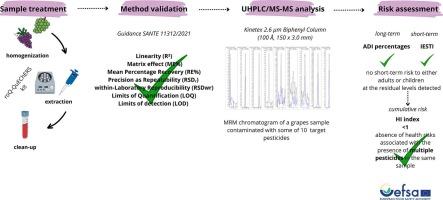用LC-MS/MS定量分析一次霜霉病侵染期间酿酒葡萄中农药残留及相关风险评估
IF 9.8
1区 农林科学
Q1 CHEMISTRY, APPLIED
引用次数: 0
摘要
农业中农药的使用对环境和消费者健康构成风险。研究了霜霉病对酿酒葡萄中10种农药残留的影响。采用roQ-QuEChERS试剂盒提取红、白葡萄样品,采用LC-MS/MS检测农药残留量。结果显示,72% %的分析样品中含有一到三种农药残留,31% %的样品含有四种以上不同的农药残留。甲螨灵和啶虫啉的检出频率最高,而平均浓度最高的是下颌丙胺(12.5 ng/mL)。所有检测到的农药含量都低于安全阈值,表明没有健康风险。使用PRIMo 4进行的风险评估证实,在检测到的残留水平下,对成人或儿童没有风险。此外,通过HI方法计算的同一葡萄样品中同时存在多种农药的累积风险低于欧洲食品安全局的参考值,因此被认为是可以接受的。本文章由计算机程序翻译,如有差异,请以英文原文为准。

Quantitative analysis of pesticide residues in wine grapes during a downy mildew infestation using LC-MS/MS and associated risk assessment
Pesticide use in agriculture poses risks to the environment and consumer health. This study analyzed 10 pesticide residues in wine grapes affected by Downy Mildew. Red and white grape samples were extracted using the roQ-QuEChERS kit, and pesticide levels were measured with LC-MS/MS. Results showed contamination with one to three pesticide residues in 72 % of the analyzed samples, with 31 % containing over four different pesticides. Metalaxyl and dimethomorph were the most frequently detected, while mandipropamid had the highest average concentration (12.5 ng/mL). All detected pesticide levels were below safety thresholds, indicating no health risks. Risk assessment using PRIMo 4 confirmed no risks for adults or children at the detected residue levels. Moreover the cumulative risk associated with the simultaneous presence of multiple pesticides in the same grape sample, calculated by the HI approach, resulted below the EFSA reference values and was therefore considered acceptable.
求助全文
通过发布文献求助,成功后即可免费获取论文全文。
去求助
来源期刊

Food Chemistry
工程技术-食品科技
CiteScore
16.30
自引率
10.20%
发文量
3130
审稿时长
122 days
期刊介绍:
Food Chemistry publishes original research papers dealing with the advancement of the chemistry and biochemistry of foods or the analytical methods/ approach used. All papers should focus on the novelty of the research carried out.
 求助内容:
求助内容: 应助结果提醒方式:
应助结果提醒方式:


